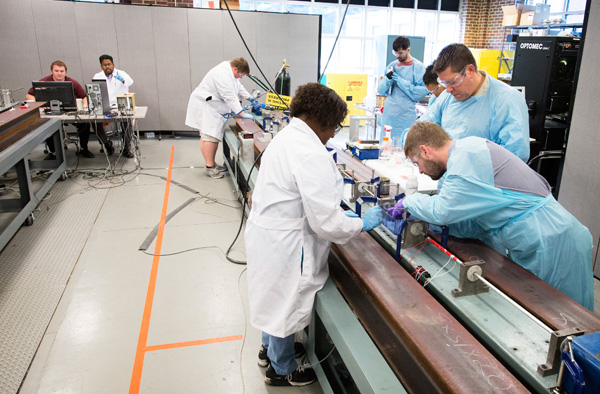Infant head-trauma research brings leading U.K. university to MSU
February 10, 2015

STARKVILLE, Miss. – After a year of planning, two European engineers visited Starkville to collaborate with Bagley College of Engineering researchers on experiments that could only be conducted in labs at Mississippi State University.
Mike Jones, a senior lecturer, and Dan Darwall, a doctoral candidate, traveled to the Magnolia State from Cardiff University, Wales, to test a theory that could save lives of child abuse victims and uphold justice in courtrooms worldwide.
“There is a lack of data, particularly in material properties at high-rates, for infants,” Darwall said. “We came to Mississippi State because this is where the experts are. The collaboration works rather nicely.”
With a career rooted in forensic pathology and experience as a court adviser on child abuse cases, Jones saw the need for more detailed information about how the newly developed head reacts to harsh impact. Unfortunately, this curiosity led to more questions than answers. As a result, the Cardiff pair teamed up with MSU students, researchers and professors to perform high-rate impact testing on three components of stillborn piglets’ skulls – scalp, brain and bone.
MSU’s experience using split-pressure Hopkinson bars is the main factor in this successful collaboration. These bars provide the most realistic data by transferring energy at very high strain rates. These rates are greater than those of traditional mechanical testing devices, creating more realistic injury scenarios.
Jones explained that the pair was willing to spend 24 hours traveling to the U.S. because of the opportunities available at Mississippi State University.
“Very few institutions have Hopkinson bars, do biological testing, and have a full team who knows how to properly use the bars,” Jones said.
Lakiesha Williams, an associate professor in biomedical engineering, has experience with researching adult head trauma. She assisted in the execution of the experiments to ensure that the results are applicable and accurate.
“Because these bars can impact at such high rates, we can obtain more data that is relative to real-life scenarios,” Williams said.
Jones and Darwall spent two weeks at the Center for Advanced Vehicular Systems conducting tests to get information for biologically-accurate computer and physical models.
“In the short-term, we’d like to have a measurement tool that allows us to determine whether certain injuries were inflicted or not,” Jones said. “We would also like to have a head that can be put onto a car crash dummy that better represents the head of an infant.”
With funding from the National Society for the Prevention of Childhood Cruelty through the Cardiff School of Medicine and departmental funding, the pair plans to continue their research until their goals are achieved, which may take more than a decade.
“For a complex model, even 10 to 15 years is ambitious, but we can make considerable gains very quickly, especially compared to what’s available in the present,” Jones said.
As an advocate for the underdog, Jones said that he will continue to encourage research and development in child safety for the remainder of his career. One of the biggest challenges in accomplishing this task is convincing companies to invest in pediatric research when the Earth’s population is overwhelmingly adult.
“I want a world filled with medical engineers who work with pediatrics and for children to get more investment because that’s where the need is,” Jones said.
Currently, this project is the only one that focuses on pediatric head trauma. As Jones and Darwall continue to research and begin to construct their models, they are optimistic that their collaboration with Mississippi State will continue to advance these efforts.
“This is a very challenging area, and Mississippi State has a great team. There’s not a corner we’ve turned that they haven’t had a solution for,” Jones said. “We’ve been more than satisfied with our work with Mississippi State. We certainly consider them experts.”
Members of the research team include (by hometown):
CARDIFF, Wales – Dan Darwall, a research scientist and doctoral candidate; and Mike Jones, senior lecturer and Gray’s Inn Barrister
CRUGER, Miss. – Biomedical engineering senior MeLanae Garett
PHILADELPHIA, Miss. – Haden Johnson, a biomedical engineering senior
PICAYUNE, Miss – Research associate at CAVS and mechanical engineering doctoral candidate Wilburn Whittington
STARKVILLE – Patrick Corley, a mechanical engineering graduate and research assistant in biomedical engineering; Jonathan Miller, a junior in biological engineering; Michael Murphy, a graduate student in biomedical engineering; Raj Prabhu, research assistant and biomedical engineering professor; and Lakiesha Williams, an associate professor in biomedical engineering
To learn more about the Bagley College of Engineering, visit www.bagley.msstate.edu.
By: Erin Boozer
